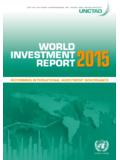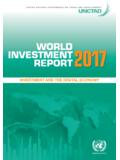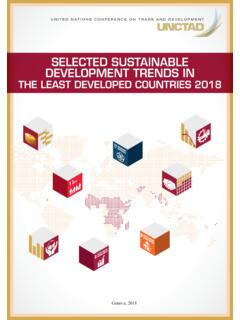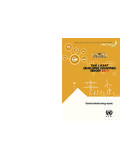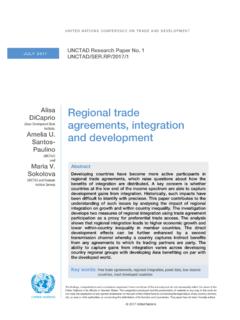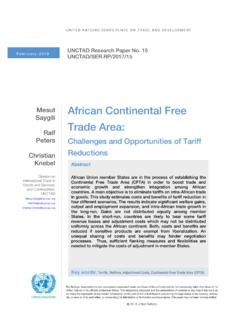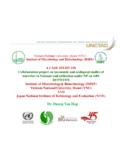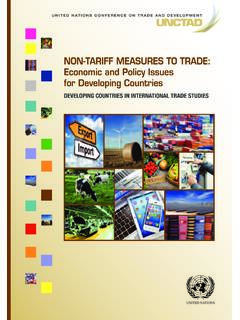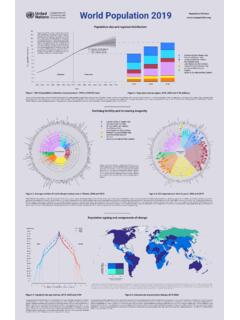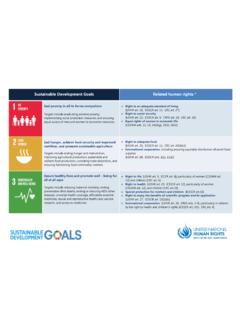Transcription of ESTIMATES OF GLOBAL E-COMMERCE 2019 AND …
1 UNITED NATIONS CONFERENCE ON TRADE AND DEVELOPMENTNo15 UNCTAD Technical Notes on ICT for DevelopmentNo18 ESTIMATES OF GLOBAL E-COMMERCE 2019 AND PRELIMINARY ASSESSMENT OF COVID-19 IMPACT ON ONLINE RETAIL 2020 ESTIMATES OF GLOBAL E-COMMERCE 2019 AND PRELIMINARY ASSESSMENT OF COVID-19 IMPACT ON ONLINE RETAIL 2020 1 COVID-19 impact on E-COMMERCE Government business-to-business (B2B) and business-to-consumer (B2C) statistics lag by over a year so 2020 data were not available at the time of this note. However, with a view to making preliminary assessment of the impact of COVID-19 on online shopping, this note draws on data on online retail sales from selected countries and from annual reports for 2020 of leading B2C E-COMMERCE companies. The full ESTIMATES for E-COMMERCE in 2019 are provided in section 2.
2 Online retail sales increase at above average rate in 2020 National statistical offices in several countries compile online retail sales on a frequent basis. Data for these countries, which accounted for 65% of GLOBAL B2C E-COMMERCE in 2019, suggest that online retail sales as a share of total retail sales jumped by 3 percentage points in 2020 (from 16% to 19%) compared to a two percentage point rise between 2018-2019 ( table 1). Notably, COVID-19 generated an increase in demand for online ordering of physical goods due to quarantine restrictions imposed in many Overall retail sales declined by 1% in this group of countries in 2020 while online retail grew by 22%. Among the countries included in table 1, the Republic of Korea had the highest online share of retail trade at in 2020, up from the year before.
3 table 1: Online retail sales, selected economies, 2018-2020 Economy Online retail sales ($ billions) Retail sales ($ billions) Online share (% of retail sales) 2018 2019 2020 2018 2019 2020 2018 2019 2020 Australia 239 229 242 Canada 467 462 452 China 1, 1, 1, 5,755 5,957 5,681 Korea (Rep.) 423 406 403 Singapore 34 32 27 United Kingdom 565 564 560 United States 5,269 5,452 5,638 Economies above 1,770 2,038 2,495 12,752 13,102 13,003 14 16 19 Source: UNCTAD, based on national statistics offices. 1 UNCTAD. 2021. COVID-19 and E-COMMERCE : a GLOBAL review. 2 COVID-19 results in mixed fortunes for E-COMMERCE companies Another perspective regarding the COVID-19 impact on E-COMMERCE can be deduced from the financial reports of leading e- commerce companies.
4 This provides a more complete picture than the online retail sales since it also covers E-COMMERCE services companies. table 2 shows data for the top 13 E-COMMERCE companies in 2020, ten of which are from China and the United States. There was a notable reversal of fortune for services E-COMMERCE companies, such as in ride hailing and travel. All of them experienced sharp declines in gross merchandize volume (GMV) and corresponding drops in ranks. For instance, Expedia fell from 5th place in 2019 to 11th in 2020, Booking Holdings from 6th to 12th and Airbnb, which launched its IPO in 2020, from 11th to 13th. Despite the reduction in services companies GMV, total GMV for the top 13 B2C E-COMMERCE companies rose by in 2020, higher than in 2019 ( ).
5 Overall, B2C GMV for these companies stood at US$ trillion in 2020. It is estimated that they accounted for just less than half of B2C E-COMMERCE GMV in 2019. table 2: Top B2C E-COMMERCE companies by GMV, 2020 Rank by GMV Company HQ Industry GMV ($ billions) GMV change (%) 2020 2019 2018 2019 2020 2018-19 2019-20 1 1 Alibaba China E-COMMERCE $866 $954 1,145 2 2 Amazon USA E-COMMERCE $344 $417 $575 3 3 China E-COMMERCE $253 $302 $379 4 4 Pinduoduo China E-COMMERCE $71 $146 $242 5 9 Shopify Canada Internet Media & Services $41 $61 $120 6 7 eBay USA E-COMMERCE $90 $86 $100 7 10 Meituan China E-COMMERCE $43 $57 $71 8 12 Walmart USA Consumer goods retail $25 $37 $64 9 8 Uber USA Internet Media & Services $50 $65 $58 10 13 Rakuten Japan E-COMMERCE $30 $34 $42 11 5 Expedia USA Internet Media & Services $100 $108 $37 12 6 Booking Holdings USA Internet Media & Services $93 $96 $35 13 11 Airbnb USA Internet Media & Services $29 $38 $24 Companies above $2,035 $2,399 $2.
6 890 Note: Alibaba year beginning 1 April, Walmart year beginning 1 February. Figures in italics are ESTIMATES . GMV = Gross Merchandize Value (as well as Booking Value). Source: UNCTAD based on company reports. 3 Box 1: E- commerce companies lagging in support of digital inclusion In December 2020, the World Benchmarking Alliance launched the first ever GLOBAL index measuring the performance of tech companies on digital inclusion (Digital Inclusion Benchmark (DIB)).2 The world's top 100 digital companies were ranked based on how they contribute to access to digital technologies, building digital skills, enhancing trust and fostering innovation. Fourteen E-COMMERCE companies were included in the DIB. E-COMMERCE enterprises performed poorly compared to companies in other digital industries such as hardware or telecommunication services.
7 For instance, the highest ranked E-COMMERCE company was eBay at 49th place. Overall, E-COMMERCE companies obtained a score of just 20 out of a possible 100. A main factor for the poor performance is that E-COMMERCE companies are relatively young, typically founded only in the last two decades. They have been more focused on shareholders rather than engaging with a wide group of stakeholders and compiling metrics on their environmental, social and governance performance. Nonetheless there are some bright spots. For instance, several E-COMMERCE companies provide free training to entrepreneurs on how to sell online including in some cases, specifically targeted at vulnerable groups such as people with disabilities or ethnic minorities. Figure 1: E-COMMERCE companies in the 2020 Digital Inclusion Benchmark Source: UNCTAD based on World Benchmarking Alliance.
8 Digital Inclusion Benchmark 2020. 2 World Benchmarking Alliance. 2020. Digital Inclusion Benchmark Synthesis Report. 0102030405060708090100010203040506070809 0100E- commerce companies in the 2020 Digital Inclusion BenchmarkRank (left)Score (right) 4 2 ESTIMATES of GLOBAL E-COMMERCE 2019 E-COMMERCE sales up four per cent in 2019 UNCTAD ESTIMATES that the GLOBAL value of E-COMMERCE sales (B2B and B2C) reached almost $ trillion in 2019 (see table 3). This corresponded to about 30% of GDP and represented an increase of 4% from 2018 ($ trillion). The estimated value of g lobal B2B e- commerce was $ trillion, representing 82% of all E-COMMERCE , including both sales over online market platforms and electronic data interchange (EDI) transactions.
9 B2C E-COMMERCE sales were estimated at $ trillion in 2019, up 11% over 2018. The top three countries by B2C E-COMMERCE sales remained China, the United States and the United Kingdom. table 3: E-COMMERCE sales: Top ten countries, 2019 Rank Economy Total E-COMMERCE sales ($ billions) Share of total E-COMMERCE sales in GDP (%) B2B E-COMMERCE sales ($ billions) Share of B2B E-COMMERCE sales in total E-COMMERCE (%) B2C E-COMMERCE sales ($ billions) 1 United States 9,580 45 8,319 87 1,261 2 Japan 3,416 67 3,238 95 178 3 China 2,604 18 1,065 41 1,539 4 Korea (Rep.) 1,302 79 1,187 91 115 5 United Kingdom 885 31 633 72 251 6 France 785 29 669 85 116 7 Germany 524 14 413 79 111 8 Italy 431 22 396 92 35 9 Australia 347 25 325 94 21 10 Spain 344 25 280 81 64 10 above 20,218 36 16,526 82 3,691 World 26,673 30 21,803 4,870 Source: UNCTAD, based on national sources.
10 Note: Figures in italics are UNCTAD ESTIMATES . Top 20 economies by B2C E-COMMERCE sales Developing and transition economies accounted for about half of the top 20 economies by B2C E-COMMERCE sales in 2019 (see table 4). In relation to GDP, B2C E-COMMERCE sales were the largest in Hong Kong (China), China and the United Kingdom. Among the top 20 economies, the extent to which Internet users engage in online purchases varies considerably. In 2019, the highest shares were observed in the United Kingdom (88%), Canada, Germany and the Netherlands (all 84%). 5 table 4: B2C E-COMMERCE sales: Top 20 economies, 2019 Rank Economy B2C E-COMMERCE sales ($ billion) Share of B2C E-COMMERCE sales in GDP (%) Online shoppers (million) Online shoppers (% of internet users) 1 China 1,539 639 75 2 United States 1,261 189 80 3 United Kingdom 251 42 88 4 Japan 178 55 54 5 France 116 38 77 6 Korea (Rep.)
